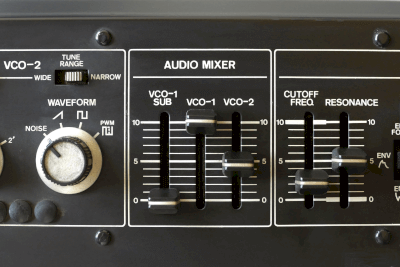What Is a Voltage Controlled Oscillator (VCO)?

A VCO is an oscillator whose oscillation frequency varies depending on the input voltage.
The output frequency range of a VCO relative to the input voltage varies, and the frequency range varies from product to product.
VCOs are generally used in PLLs (phase-locked loops), also called phase-locked circuits, which synchronize the phase of input and output signals to stabilize the frequency.
Uses of VCOs
VCOs are used for frequency control purposes in various electronic applications. Specific applications include media players, digital cameras, consumer audio equipment, communication systems such as cellular phones, wireless LANs, radios, TV tuners, GPS, and Bluetooth.
VCOs are mainly used as PLLs to stabilize frequencies in electronic devices that handle particularly high frequencies.
Principle of VCOs
The principle of VCO lies in the operation of generating the desired frequency by means of an amplifier circuit that maintains and amplifies the power at the resonant frequency, with a circuit that allows the resonant frequency to be varied by voltage in part of the oscillation circuit in order to control the oscillation frequency of the oscillation circuit that generates the radio waves by voltage.
There are three main methods of generating the resonant frequency of VCOs: ring VCOs, LC VCOs, and VCXOs.
1. Ring VCOs
Ring VCOs are VCOs that have multiple stages of inverters and are connected in a ring shape to form an oscillation circuit. The oscillation frequency can be controlled by the number of inverter stages and the gate delay. The number of stages and the delay can be controlled by an external bias current.
They are widely used in PLLs due to their excellent frequency tuning range. However, they are susceptible to power supply noise and generally do not have a high degree of frequency stability.
2. LC VCOs
LC VCOs are VCOs composed of an LC oscillator and a varactor. A varactor is a diode whose PN junction capacitance can be varied according to the applied voltage. By varying the capacitance, the oscillation frequency caused by the resonance of the LC is changed, and the oscillation frequency of the VCOs is varied by the voltage.
3. VCXO
A VCXO is a VCO that uses a quartz crystal (Xtal). The crystal has a high Q-value (Quality factor), resulting in high-frequency stability. At the same time, the range of output frequencies that can be varied is narrower.
VCOs can also be made using ceramic or SAW crystals instead of quartz crystals. Compared to a quartz crystal, a VCO can have a larger variable frequency range, but a quartz crystal is superior in terms of stability.
Other Information on VCOs
1. Implementation of VCOs
VCOs can be implemented in a variety of ways, depending on their frequency and application. The factor that determines the oscillation frequency is the LC value. However, since relatively large inductors and capacitors are required to oscillate at low frequencies, it may not be suitable for miniaturization and cost reduction if everything is implemented in an IC. In many cases, depending on the situation, chip components, crystals, MEMS, ceramic substrates, or other oscillators are used. In such cases, they are mounted as VCO modules.
On the other hand, for wireless communications such as RF high-frequency and millimeter waves, there are cases where VCOs are used as a part of RFIC, including integration with PLLs, mixers, and digital logic.
2. Phase Noise of VCOs
Reducing the phase noise of VCOs is a very important characteristic in wireless communication applications, as it is closely related to PLL jitter, modulation accuracy (EVM), and other characteristics. Reducing phase noise is essential for achieving high-quality communications, and manufacturers are working hard to reduce this noise.
Although it is also related to oscillation frequency stability, raising the Q-value of the resonant circuit of the VCOs is very effective in reducing the phase noise of the VCOs and is also essential for good PLL characteristics. On the other hand, it is sometimes difficult to realize a high Q-value by using a single chip IC from the viewpoint of material properties, and a high Q-value also affects the frequency tuneable range.
Recently, with the development of analog and digital circuits, VCOs with built-in filters to reduce noise and multiplier circuits to expand the frequency tuning range have been introduced to achieve both noise reduction and frequency tuning range.